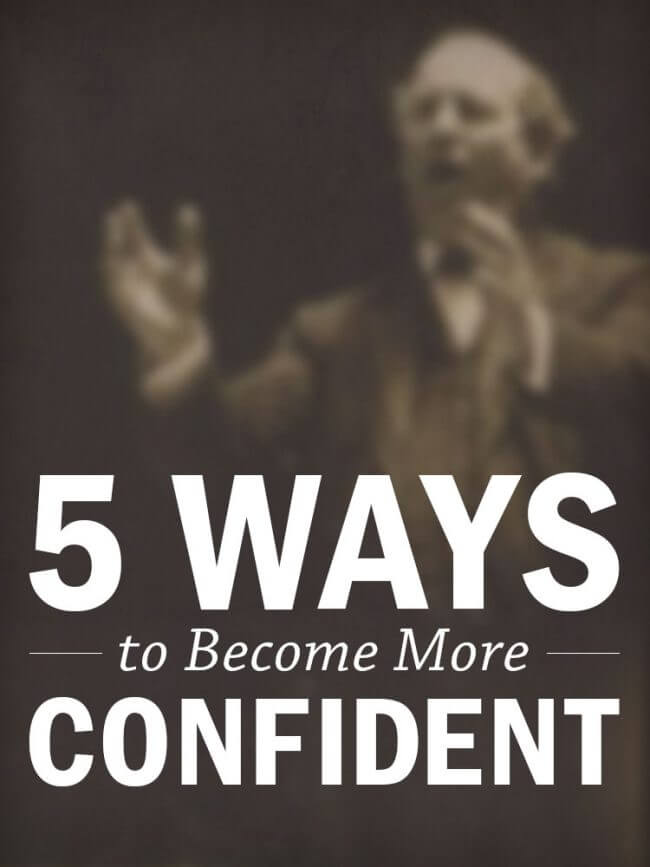Today, we’re going to go through five effective strategies you can use to build your confidence.
These strategies come from my personal experience, and they’ve all been pivotal in the development of my own self-confidence.
Rather than keep you in suspense, I’m going to tell you what they are right up front:
- Gain experience. Do that which you wish to become confident in doing.
- Understand the perspective of other people. Most importantly, realize that they don’t think about you nearly as much as you might believe.
- Realize that people love confidence. The average, everyday human experience is normal, mundane, and unmemorable – yet people crave novelty and excitement.
- Record your accomplishments. Write them down and use the resulting archive to remind yourself of your ability to overcome future challenges.
- Focus on other people. Speak less, smile more, and develop active listening skills; building up other people in your interactions will make people like you and help you build internal self-confidence.
If this quick overview is enough to help you take action and start building confidence, then get out there and start building it.
Otherwise, sit tight and keep your finger poised over that scroll wheel on your mouse; next, I’ll be digging into each of these strategies, sharing how I personally implemented them, and demonstrating how you can use them in your own life.
Competence Breeds Confidence
Simply put, gaining skills and experience in any discipline will make you more confident when you’re doing it. The key is to look at everything as a discipline – a skill to be learned and mastered. This includes social activities, like speaking in public, meeting new people, and even making small talk.
William Jennings Bryan, who was U.S. Secretary of State from 1913-1915, put it this way:
“The way to develop self-confidence is to do the thing you fear and get a record of successful experiences behind you.”
Bryan was a man who backed up his words with action; as a presidential candidate, he gave over 500 speeches in 1896 alone.
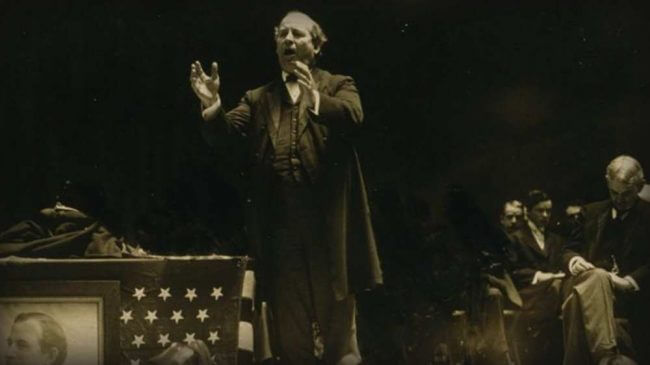
In fact, he’s the man credited with inventing the “stump speech tour” – in that era, presidential candidates mainly stayed at home. His efforts paid off; though he didn’t win the 1896 presidential election, he did secure a presidential nomination from the Democratic party – and he was (and still is) the youngest to do so in any major party, being only 36 at the time.
Beyond his political success, though, Bryan is known as one of the greatest orators in American history. Without a doubt, the confidence and passion that helped him to earn that reputation were built bit by bit, over the course of hundreds of speeches.
Regardless of the skill you want to become more confident in, this is how you do it.
That being said, I’m not just going to leave this at a Shia Labeouf-esque, “Just do it!” cliche. We can dig further, and that’s because there are two types of experience through which you can build skills and, consequently, greater confidence:
- Direct experience: Hands-on practice within the actual skill area.
- Indirect experience: Experience in any skill that has shared qualities with the main skill
The second type of experience is important to acknowledge, as gaining it can help you to build confidence much, much faster than normal. Almost every skill in the world has aspects and qualities that it shares with other skills and pursuits; by practicing those related skills, you’re basically pulling double duty.
Here are a couple of examples that illustrate this point.
Example #1: Skiing
Skiing is perhaps my absolute favorite thing to do in the world. The rush of flying down a mountain, carving fresh powder, and slipping between trees is pretty much the pinnacle of what “fun” means to me.
But, in a cruel twist of fate, I grew up in the flat plains of Iowa. No good skiing can be found anywhere close to where I live; as a result, I’ve only been skiing 6-7 times in my life – one day on a teeny tiny bunny hill here in Iowa, and a couple of three-day trips out to Colorado.
Here’s the interesting thing, though; despite my lack of time spent on the slopes, I can ski double black diamond runs. I’ve learned how to navigate moguls, I can pull off basic jumps in the freestyle parks, and while going up to the highest point at Breckenridge last March was a bit scary, I was still able to manage it.
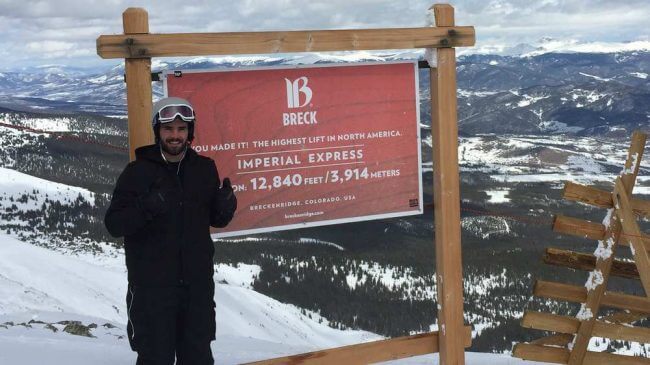
The reason I’m able to do these things despite a relative lack of direct experience on the slopes is because I started figure skating at the beginning of 2016.
I got into it when friend of mine asked me to take a basic ice skating class with him, as he wanted to start playing hockey and needed to learn. I thought it sounded fun, so I said sure thing – but I needed to buy skates. And since I didn’t know exactly what I wanted to do with ice skating (hockey and figure sounded equally interesting), the guy at the skate shop recommended that I start learning with a pair of figure skates.
As I got into it, I found skating to be a ton of fun. Additionally, since I spent a lot of my teenage years skateboarding and rollerblading, I took to it pretty quickly (another example of indirect experience being beneficial).

Since I was making good progress in my classes and having fun doing it, I decided to kick things up a notch. I started showing up for solo practice sessions, eventually working my way up to practicing five days a week. Soon after that, I hired a professional coach – who proved to be immensely helpful (it’d be hard to overstate how much she has helped me progress).
Then, in March of 2016, I went on a ski trip with my friend Matt Giovanisci. Before this trip, I’d only been out to Colorado once, so my number of total ski days was probably four. At the end of that previous trip, I had been able to ski blue runs, but black diamond runs were a bit beyond my level.
I remember wondering if the couple of months spent figure skating would help my skiing; after all, both activities involve sliding across a frozen surface at high speeds.
What I discovered is that, yes, figure skating experience compliments ski experience – to a degree that truly surprised me. After a couple of initial runs to familiarize myself with skiing again, I was able to push my abilities far beyond where they’d been at the end of the last trip. I was almost in disbelief at how much figure skating helped me.
Example #2: Public Speaking
To compliment the previous example, let’s look at something a bit more professional – public speaking.
I’m not sure if I’d call myself a professional speaker, but in the past year speaking has become a significant part of my business. In addition to making YouTube videos and running this website, I now regularly speak at universities, conferences, and other events – and get paid to do it.
When I get up on stage, I have fun. My confidence runs high, I get really animated, and I do a lot of audience interaction. I’ve come to love speaking in front of an audience.
This wasn’t always the case, however. Early on in high school, I was downright terrified of speaking in public. Whenever I had to speak in front of a class, I’d get really nervous and my hands would start shaking. Then I’d get worried that people could see them shaking, which made me even more nervous… it was a vicious cycle.
Against all odds, I survived those early speaking ordeals. When I got to my junior year of high school, I took a speech class that really helped me to calm my nerves. After that, I joined a club called Business Professionals of America and eventually got elected as the State Treasurer for Iowa – which required me to speak in front of around 500 students at the annual state conference.
Still, my speaking abilities had a long way to go before anyone would call them anything more than “serviceable”.
During my speech at the BPA state conference, I stood behind the podium and pretty much stared down at my notecards the whole time – looking up at the audience was something that took effort. If you’ve played SOMA, you know how your character starts going insane if you look at the monsters for too long? Yeah, it was kinda like that.
So how did I go from there to where I am today? How did I go from this:
…to this?
I’m not going to kid around – the greatest contributing factor was direct speaking experience. However, there was something else… and that something was podcasting.
In early 2013, I started the College Info Geek Podcast. Doing this involved purchasing a big, honkin’ microphone (a Blue Yeti in the beginning, if you’re curious) and speaking loudly while sitting alone in my bedroom.
When I started, I felt too embarrassed to do this when my roommates were home; I had to wait for all of them to leave before I could record solo episodes. And when I’d interview a guest on Skype, I’d get really nervous and constantly worry about forgetting what to ask them or somehow screwing up.
Today, though, I have over 130 episodes under my belt – along with over 120 additional episodes on Listen Money Matters – my confidence as a podcaster has increased exponentially. It’s pretty apparent, too; here’s my first episode:
…and here’s a recent episode that you can compare it to:
As you can probably guess, though, there was a side effect – my ability to speak in public increased as well. Podcasting isn’t the same thing as public speaking, but it’s similar – you have to speak clearly, sound confident, and deliver a compelling message. Additionally, you know you’re speaking for an audience. Granted, it’s not an audience that will hear you in real-time, and you have the ability to edit later on – but you still know that the words you’re saying are meant to be heard by many.
I won’t go too far into it, but making YouTube videos has had a similar effect on my public speaking abilities. In fact, it’s even more directly applicable than podcasting since the audience can see me speaking.
By the way, if you’d like to become a better public speaker, here’s a video (along with a full article) with some tips:
A Word of Warning
Before I move on from this admittedly lengthy elucidation on why indirect experience is so useful, I do want to warn you about one potential pitfall:
It can be very easy to use ancillary practice as a delay tactic for gaining direct experience.
Being able to build confidence and skills through related skills is very useful, but it’s a double-edged sword. Some people delude themselves into thinking they’re progressing just fine this way, when in reality they’d achieve their goals and gain confidence much more quickly by facing their fears and jumping head-first into that main skill.
I’ve fallen victim to those same delusions multiple times in my life – even during my childhood.
When I was eight years old, I got my first Game Boy Color and a copy of Pokémon Blue.

From the moment I turned on the game, I was hooked – but I also had some trouble initially. See, I’m one of those people who has simply excellent taste, which means I always choose Charmander as my starter.
This is a perfectly fine decision in the long run, but the fact of the matter is that Charmander isn’t very useful against rock-type Pokémon – which is exactly what the first gym leader, Brock, uses.
As a kid, I thought I had the perfect strategy for overcoming this problem:
“I’m just going to train for hours in the easy areas – I’ll train for so long and build up my Pokémon so much that I’ll CRUSH Brock.” – 8-year-old me
I spent a ton of time grinding in the game’s early areas, waiting until my Pokémon were so strong that the first gym battle wasn’t even challenging. I thought I was doing so well – until I realized later on that there’s no additional benefit to winning easily. Absolutely none.
Had I decided to fight Brock earlier, I probably would have lost once or twice, sure. But that’s no problem – when you lose, you just wake up at the Pokémon Center no worse for the wear.
Eventually, I would have won. Even if it was by the skin of my teeth, I would have pocketed my Boulderbadge and been on my way – and it would have been far earlier. Instead of wasting time grinding in the early areas, I would have been able to move into areas where progress comes much more quickly.
In later playthroughs, this is the exact strategy I used. I don’t care if I lose a battle now – when I know I’ll recover with barely any consequences, there’s no reason not to try before I feel like I’m ready.
And that’s exactly how I approach real-life skills as well. If I’m reasonably confident that I don’t stand to lose very much by trying something, I’m going to try it. And that’s exactly what you should do as well.
As Mark Victor Hansen puts it in his book The One-Minute Millionaire:
“Don’t wait until everything is just right. It will never be perfect. There will always be challenges, obstacles and less than perfect conditions. So what. Get started now. With each step you take, you will grow stronger and stronger, more and more skilled, more and more self-confident and more and more successful.”
Don’t spend too much time in the ancillary areas – before you think you’re ready, find a way to jump into the main skill. It’ll be stressful, it’ll be difficult, and it’ll be scary. But those are precisely the qualities of an experience that boost your skill and confidence levels quickly.
If you want to get faster, you don’t do it by jogging – you do it by sprinting until you’re winded.
If you want to bench press more, you don’t do it by doing a bunch of push-ups – you do it by pushing yourself to bench more weight every single week.
If you want to become a great speaker, you can’t just sit in your room and podcast all the time. It can be helpful, as I mentioned before – but eventually you have to get your butt up on a stage and speak.
Do it sooner rather than later.
Two States of Other People: 😃 or 😐
“You wouldn’t worry so much about what others think of you if you realized how seldom they do.” – Eleanor Roosevelt
Let me ask you a question: When you have to get up on stage to speak, or shake that new person’s hand, or demonstrate a skill you’ve been learning in front of people, what scenarios run through your head?
If you’re anything like I used to be, at least one of those scenarios is this one:
“I’m going to screw up, and everyone’s going to get mad. They’ll probably hate me for-freakin-ever. It’s possible they’ve all brought rotten produce, and I’m probably going to have to resurrect my elementary school dodgeball skills.”
Here’s another, related question: What goes through your head when you see a 10/10 smokin’ hot person across the room, who you’d just love to ask on a date?
“I can’t ask her out; she’ll think I’m a creep and probably throw her drink on my face. All her friends will probably laugh at me too. And I’m pretty sure I’ll spontaneously burst into flames.”
Our brains have evolved to weigh negative experiences more heavily than positive ones, so we’re constantly on the lookout for threats, and we war-game disaster scenarios in our heads. To put that another way, it’s totally normal to imagine a negative reaction from other people.
But here’s the thing….
When’s the last time you booed someone off a stage for giving a less-than-stellar performance? When’s the last time you threw your drink on someone’s face and called them a creep for asking you out?
Unless you’re a complete tool, the answer to both of those questions is never.
Furthermore, I’m pretty confident that you rarely, if ever, see anyone else behaving like that. This is the key realization:
We all worry that people are going to react negatively, but they almost never do.
When they’re in public, people pretty much have two states:
- Normal/bored/whatevs
- Dazzled
This realization hit me like a ton of bricks when I was taking a speech class in college. On big speech days, everyone in the class had to take turns going up to the front of the room and delivering their speech.
A few of the people in that class were really good. When those people spoke, the audience was rapt. Their reaction was ideal, and I’m sure those speakers were really happy about that.
The rest of us ranged from just ok to… well… not so great. And as I sat in class watching each of these less-than-stellar (I mean that literally this time instead of as a euphemism) speakers, I looked around at the audience. What I saw was… utterly mundane. And yet it was profound.
Some people were politely paying attention. Some people were spacing off. Some people were sneakily looking at their phones.
Not a single person did anything that could be perceived as an attack on the presenter. That’s because they weren’t really thinking about the presenter at all. The presenter failed to dazzle them, so they went back to their normal state: thinking about themselves.
Once I realized that, something clicked in my brain:
“I have NO reason to avoid putting myself out there, because no one is going to berate me if I fail. If I do well, I’ll dazzle them. If I don’t, they just won’t remember me… which is exactly what would happen if I did nothing at all.“
It’s simple, but it’s powerful. People have two states: dazzled and indifferent. Neither one can harm you, so neither one should stop you.
Give the People What They Want
Once I figured out that other people were either going to be dazzled or indifferent, I came to understand a couple of other things.
First, I realized that people spend most of their time in the indifferent state. It’s just a consequence of normal, everyday life – things become routine, not much changes, and a lot of the activities you go through aren’t exactly “fun”. They’re mostly obligations or habits.
Put another way, the default reaction to most situations is:

Secondly, I realized that people crave being in the other state. They want to be dazzled. The “meh” state is boring – people want something novel, something exciting, something that breaks the mold.
And who are the people that normally create new, novel, and exciting things? To name a few:
- Comedians
- Inventors
- Visionary businesspeople
- Great speakers
- Actors
- Axe murderers
- Quirky museum tour guides
All of these people have one thing in common: confidence.
After realizing that people crave novelty and excitement, the next realization for me was that confident people are more able to deliver those things.
I now had what amounted to three pieces of a puzzle:
- People are either “meh” or dazzled
- People want to be dazzled
- Confident people can dazzle better than unconfident people
Putting those together, I came to this conclusion about how I should act going forward:
“Act confident even if I don’t feel confident. It’s what people want, and if I screw up, it’s fine. They’ll just be indifferent.”
It seems obvious, but for some reason, deliberately asserting that to myself actually helps me to act more confidently. And, by acting confidently and getting good results from doing so, I’ve actually become more confident.
But that begs the question… how you do act confidently when you don’t actually feel that way? Well, here’s an example of how I do it.
To give you some backstory: A few weeks ago my girlfriend Anna and I drove up to the Minnesota Renaissance Festival. While we were there, we decided to catch a couple of the scheduled shows that were being put on.
The first was a standard comedy routine; two guys stood up on a stage, told a bunch of jokes, and got a bunch of yuks. But the second show… oh boy. The second show featured a lot of audience participation.
And wouldn’t you know it – I was the lucky guy picked out of the crowd to do the most audience participation of all. This eventually culminated in me having to put a bra on my head in front of over 100 people while giving my best evil laugh.

I’ll be honest – when I was younger, there was no way I’d have done something like this. I would have just done my best to ignore the performers when they called me out.
Now, however, I’m a bit more confident and comfortable with looking silly. Furthermore, as I looked out at the audience, I realized that the hundred or so people in front of me had all paid money to be there. They wanted to have a good time.
Still, I’m standing up there and I’m feeling a bit ridiculous. So here’s the mental process I went though to enable myself to put a little gusto into my ridiculous situation. This is the same mental process I go through when I’m about to give a speech as well.
First, I created a totally stereotypical person in my head.
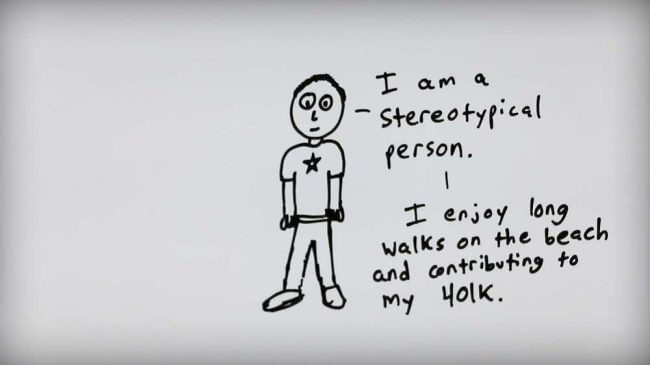
Then I asked myself,
“What would this completely stereotypical person do in a situation like this?”
Well, he’d probably…
- Use small, restrained gestures
- Speak softly
- Avoid making eye contact with people in the audience
- Look back to the performers to guide his actions
Once I’d listed those things out to myself, I reminded myself of what would happen if I acted like that. Namely, the audience members would simply think,
“Meh.”
I told myself that’s the worst thing that can happen. Once that was established, I came to the final step:
I committed to being better than that stereotype.
Even though I felt silly (and a little scared), I stepped into the role of someone far more confident. I told myself that if I could simply outperform the stereotypical person in my head, the people in the audience would be happier and have a better time.
And that’s exactly what I did. I acted like a complete fool, improvised, and ended up having a lot of fun – along with everyone else on stage and in the audience.
Record Your Accomplishments
The last two tips have been about making changes to your mindset; this one, by contrast, involves adopting a real-world practice. It’s a simple one, too.
When you accomplish something worthwhile, record it. Make a note of it somehow.
I’ve done this in two different ways, both of which are useful. First, I’ve tried keeping a daily accomplishment journal. For me, this took the form of an Evernote notebook.
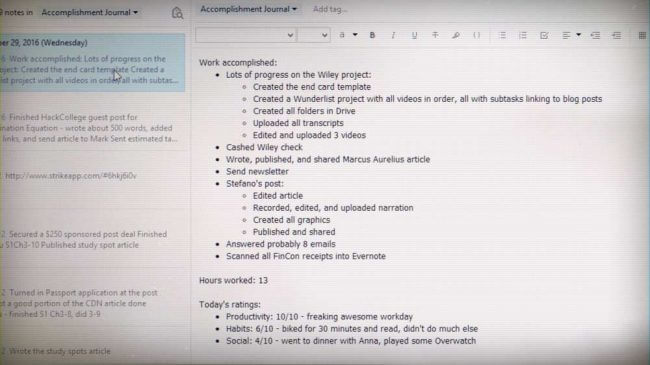
At the end of each day, I’d make a new note and write down all the work I’d done. If something stood out, I’d bold it.
I don’t do this anymore, however, because I’ve found that my Impossible List works better for me. Put simply, the Impossible List is an ever-evolving list of my life’s biggest goals. It has a couple of qualities that differentiate it from a standard bucket list:
- I keep a record of most recently achieved goals, along with their dates, to remind myself to keep moving forward
- When I accomplish a goal, I iterate upon it by adding a more difficult follow-up goal underneath it
If you’d like to learn more about the Impossible List concept, here’s a video I made about it:
Whether you decide to create an accomplishment journal, an Impossible List, or something else, the principle here is the same – if you can look back at your past accomplishments, you’ll be able to see a concrete record of your own ability to overcome challenges.
Seeing this record will help you to re-affirm the fact that you absolutely can overcome whatever you face in the future. You’ve done it before – why shouldn’t you be able to do it again?
Make the Other Person Feel Special
This final piece of advice is a little different, as it takes the focus off of you and puts it on the other person within any interaction you’re having. A personal friend of mine told me this, and I’ll paraphrase it here:
“Speak more slowly, say less, smile more, and focus on listening intently to the other person.”
Essentially, your main goal in any interpersonal situation should shift from, “How do I make myself look good?” to, “How can I make this person feel special?” You do that by:
- Listening intently
- Asking good follow-up questions
- Reacting enthusiastically and laughing readily
- Refraining from any one-upmanship
- Smiling more, speaking more slowly, etc.
Think about the last time you were in a conversation with someone who did all of these things. How did their reactions and mannerisms make you feel? Probably like a million bucks, right?
We love it when other people react positively to what we’re saying. When someone laughs at a joke we tell, or seems genuinely interested in what we’re saying, it feels amazing. As William James put it:
“The deepest principle in human nature is the craving to be appreciated.”
As a result, adopting these practices in your interactions is going to make you a lot of friends. It’s a recipe for becoming a well-liked person, which can help you to forge new relationships and build a large network easily. It’ll also simply make you happier.
What may be surprising, however, is that these practices will help you become more internally self-confident. That’s because the majority of your conversations and interactions will end positively, and you’ll come out of them feeling really good about yourself – even though you didn’t have to do anything to build yourself up.
Once you get some real-world proof that you can have great interactions without needing to try to make yourself look good, or to one-up what someone else said, you’ll start to feel naturally self-confident. And the way people will treat you will simply reinforce that feeling.
If you’re unable to see the video above, you can view it on YouTube.
Looking for More Study Tips?

If you enjoyed this article, you’ll also enjoy my free 100+ page book called 10 Steps to Earning Awesome Grades (While Studying Less).
The book covers topics like:
- Defeating procrastination
- Getting more out of your classes
- Taking great notes
- Reading your textbooks more efficiently
…and several more. It also has a lot of recommendations for tools and other resources that can make your studying easier.
If you’d like a free copy of the book, let me know where I should send it:
I’ll also keep you updated about new posts and videos that come out on this blog (they’ll be just as good as this one or better) 🙂
Video Notes
Here are some related articles you might want to check out:
Have something to say? Discuss this episode in the community!
If you liked this video, subscribe on YouTube to stay updated and get notified when new ones are out!


